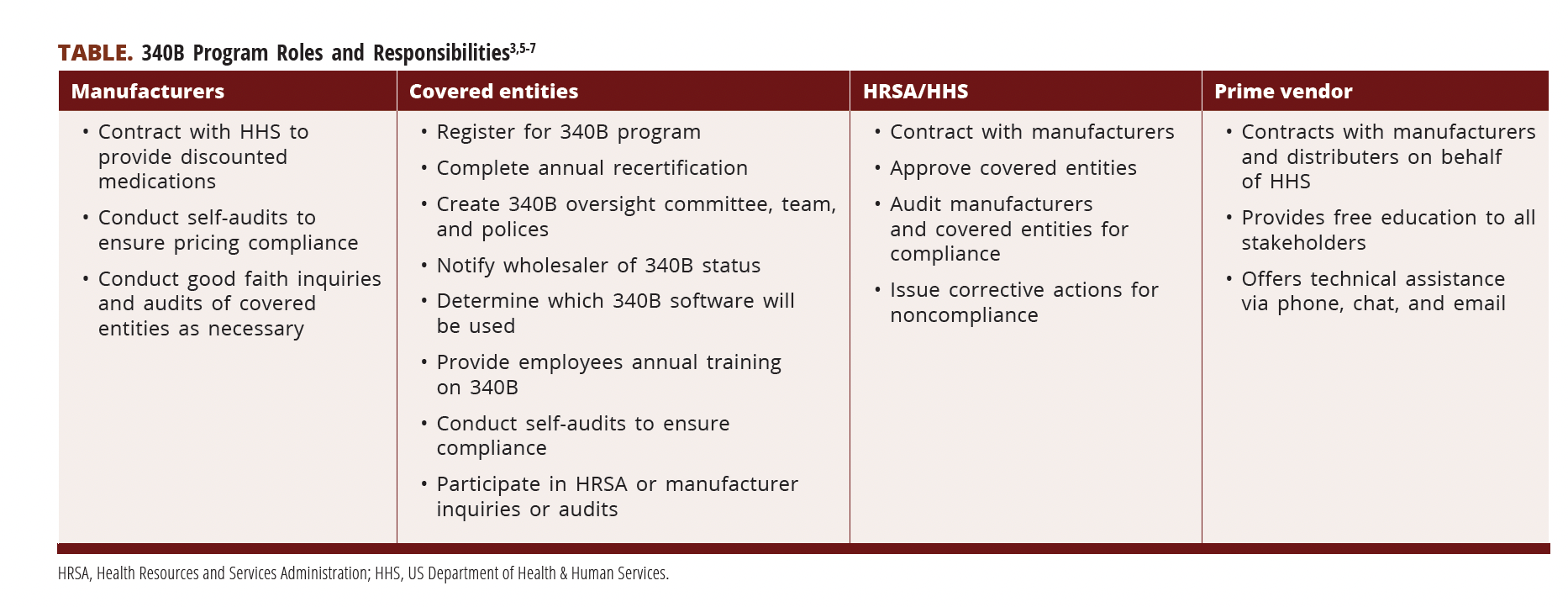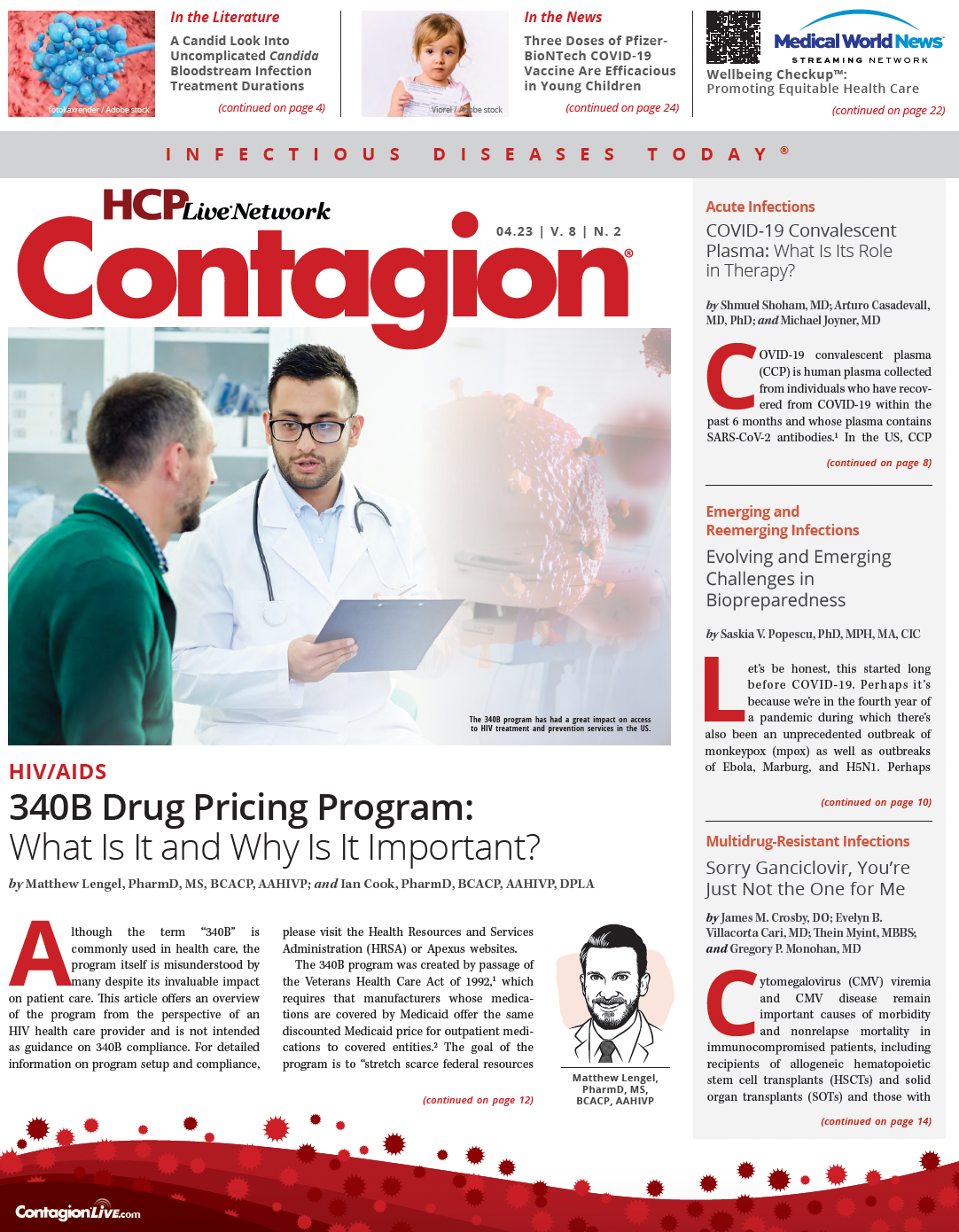340B Drug Pricing Program: What Is It and Why Is It Important?
The 340B program has had a great impact on access to HIV treatment and prevention services in the US.
Although the term “340B” is commonly used in health care, the program itself is misunderstood by many despite its invaluable impact on patient care. This article offers an overview of the program from the perspective of an HIV health care provider and is not intended as guidance on 340B compliance. For detailed information on program setup and compliance, please visit the Health Resources and Services Administration (HRSA) or Apexus websites.
The 340B program was created by passage of the Veterans Health Care Act of 1992,1 which requires that manufacturers whose medications are covered by Medicaid offer the same discounted Medicaid price for outpatient medications to covered entities.2 The goal of the program is to “stretch scarce federal resources as far as possible, reaching more eligible patients and providing more comprehensive services.”3 In general, covered entities are facilities whose patients are from the most vulnerable populations, live in low-income households, and are frequently uninsured,2,3 and they include certain nonprofit hospitals and federal grantees/clinics.
1.Hospitals
a. Disproportionate share hospitals (DSHs)
b. Children’s hospitals
c. Free-standing cancer hospitals
d. Sole community hospitals
e. Rural referral centers
f. Critical access hospitals
2. Federal grantees
a. Federally qualified health centers (FQHCs) or FQHC “look-alikes”
b. State-operated AIDS drug assistance programs
c. Ryan White Comprehensive AIDS Resources Emergency (CARE) Act clinics and programs
d. Tuberculosis clinics
e. Black lung clinics
f. Title X family planning clinics
g. Sexually transmitted disease clinics
h. Hemophilia treatment centers
i. Urban Indian clinics
j. Native Hawaiian health centers
Under the 340B program, covered entities can purchase outpatient medications from manufacturers at a discounted rate that is predetermined through an agreement between the manufacturer and the secretary of Health & Human Services.3 The Government Accountability Office reports 340B savings of between 20% to 50% for covered entities.4 The covered entity administers or dispenses discounted medications through entity-owned or contracted pharmacies. If the patient has insurance, the pharmacy will bill the insurance and receive reimbursement for the medication at standard rates.3 But because the medication was purchased at a discount, this results in an increased reimbursement amount, or “340B savings,” that is used by the covered entity to expand patient care services.3
(Click to enlarge)

Once a facility is registered as a 340B covered entity, a patient fill is deemed eligible for 340B discounts if:
- The covered entity has an established relationship with the patient and maintains health care records for the patient.
- The patient receives health care services from a health care professional employed or contracted by the covered entity. These services must be more than just the dispensing of medication(s).
- The patient receives health care services that are within the range of services for which the covered entity receives grant funding or services that it is federally qualified to provide.
To implement a 340B program, covered entities must determine an inventory replenishment model and create a process for identifying eligible patients. Covered entities or their contracted pharmacies can choose a physical or virtual inventory model. Physical models require separating or designating inventory on pharmacy shelves as either 340B or non-340B. This requires a large amount of inventory and space. Additionally, it requires pharmacy staff to properly identify whether they are filling for a 340B eligible patient and then use the correct inventory. Due to these prerequisites, many entities opt for a virtual inventory replenishment system that utilizes the same inventory for all patients but tracks the dispensing to 340B-eligible patients retrospectively, which determines replenishment from either regular or 340B accounts. This model essentially requires covered entities to advance medication from their non-340B accounts, but it makes it easier to manage inventory and track the dispensing of 340B medication.
It is important that covered entities establish appropriate processes and systems to manage their program and maintain strict compliance with HRSA 340B rules and regulations. A primary requirement is to correctly identifying eligible patients. Using 340B discounts for ineligible patients is referred to as “diversion.” Although the concept of eligibility is straightforward, our complex health care system can make it difficult to comply with it. Most covered entities use third-party software to compile health care and medication fill data to identify fills for eligible patients. These systems not only help identify patients but are often integrated into the covered entity and wholesaler systems to track and set order points for 340B accounts and maintain auditable records. Another major requirement is avoiding duplicate discounts. As previously mentioned, manufacturers offer drug discounts to Medicaid. If covered entities choose to include, or “carve in,” Medicaid patients in their 340B program, they must ensure that the manufacturer does not apply the discount to both Medicaid and the covered entity. Covered entity compliance is enforced through annual recertification and HRSA audits. Drug manufacturers can also audit covered entities in certain situations.
Covered entities can use 340B savings to fund patient programs such as smoking cessation, pharmacist home visits, pill box services, appointment transportation, medication and medical services access, healthy food, case management, insurance navigation, and many other services that patients need but are not covered by insurance companies.8 340B disproportionate share hospitals (DSHs) have been shown to serve significantly more low-income patients, have higher (27.4%) unreimbursed and uncompensated care costs, offer more specialized and community service programs and more medication access services than non-340B hospitals.9,10

The 340B program has had a great impact on access to HIV treatment and prevention services in the United States. 340B savings are used to support invaluable patient programs like medication delivery and pill box or blister packing and are used to cover medication copays and costs.11 These funds are also used to expand and stretch the federal funding that HIV clinics receive through the Ryan White program and supplement reimbursement from Medicaid and AIDS Drug Assistance Programs, which can be affected by politics in the state.11 Many of these vital services, which promote Ending the HIV Epidemic initiative by removing medication access barriers and helping patients achieve and maintain viral suppression, would not be possible without the 340B program.11
References
1. H.R.5193 - 102nd Congress (1991-1992): Veterans Health Care Act of 1992. Congress.gov, Library of Congress, 4 November 1992, https://www.congress.gov/bill/102nd-congress/house-bill/5193.
2. Fact sheet: the 340b drug pricing program. American Hospital Association. March 2021. Accessed February 21, 2023. https://www.aha.org/fact-sheets/2020-01-28-fact-sheet-340b-drug-pricing-program
3. 340B drug pricing program overview. 340B Health. Accessed February 21, 2023. https://www.340bhealth.org/members/340b-program/overview/
4. Drug pricing program: HHS uses multiple mechanisms to help ensure compliance with 340B requirements. United States Government Accountability Office. December 14, 2020. Accessed February 27, 2023. https://www.gao.gov/products/gao-21-107
5. 340B drug pricing program integrity. US Department of Health & Human Services. June 25, 2020. Accessed February 21, 2023. https://www.hhs.gov/guidance/document/340b-drug-pricing-program-program-integrity-0
6. Getting started in 340B checklist. 340B prime vendor program. Accessed February 21, 2023. https://340bpvp.com/Documents/Public/340B%20Tools/grantee-getting-started-in-340b-checklist.xlsx
7. What is the 340B prime vendor program? Apexus. Accessed February 21, 2023. https://www.apexus.com/340b-prime-vendor-program
8. 340B helps the most vulnerable patients. Association of American Medical Colleges. March 3, 2019. Accessed February 21, 2023. https://www.aamc.org/news-insights/340b-helps-most-vulnerable-patients
9. L&M Policy Research, LLC. Analysis of 340B disproportionate share hospital services to low- income patients. March 12, 2018. Accessed February 27, 2023. https://www.340bhealth.org/files/340B_Report_03132018_FY2015_final.pdf
10. Rana I, von Oehsen W, Nabulsi NA, et al. A comparison of medication access services at 340B and non-340B hospitals. Res Social Adm Pharm. 2021;17(11):1887-1892. doi:10.1016/j.sapharm.2021.03.010
11. The 340B drug pricing program success story: Ryan White HIV entities. Wellpartner. Accessed February 21, 2023. https://www.wellpartner.com/thought-leadership/340b-drug-pricing-success-ryan-white-hiv-entities/

